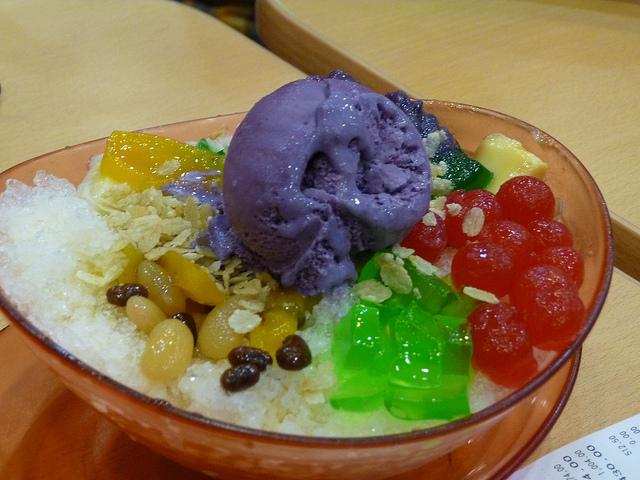
Halo-Halo
Probably because of the abundance of available ingredients as a tropical country or because of the limitless imagination and creativity with almost anything edible, Filipinos have always enjoyed creating, and eating, truly unique and delicious desserts that can definitely satisfy ones cravings for sweets. But then again, these desserts may make you crave for more.
Some desserts that are uniquely Filipino are:
1. Halo-halo is a popular Filipino dessert that is a mixture of shaved ice and evaporated milk to which are added various boiled sweet beans and fruits, and served in a tall glass or bowl.
Ingredients include boiled kidney beans, garbanzos, sugar palm fruit (kaong), coconut sport (macapuno), and plantains caramelized in sugar, jackfruit (langkâ), gulaman, tapioca, nata de coco, sweet potato (kamote), pounded crushed young rice (pinipig). In terms of arrangement, most of the ingredients (fruits, beans, and other sweets) are first placed inside the tall glass, followed by the shaved ice. This is then sprinkled with sugar, and topped with either (or a combination of) leche flan, purple yam (ubeng pula), or ice cream. Evaporated milk is poured into the mixture upon serving.

2. Leche flan (from leche, Spanish for milk) is a caramel custard, made with eggs, milk and sugar and flavored with vanilla. It originated from the regions along the border of France and Spain and was brought to the Philippines at the time of Spanish colonization. The ingredients are mixed and poured in an oval or round pan which is then placed in a larger pan of water and cooked on a stove or in an oven. The dessert, once firm, is chilled before serving. The sugar, after cooking, turns into a caramel syrup that coats the custard. Pieces of leche flan are sometimes added to halo-halo.

3. Sapin-sapin is a layered glutinous rice and coconut dessert in Philippine cuisine. It is made from rice flour, coconut milk, sugar, water, and coloring with coconut flakes sprinkled on top. Sapin-sapin means "layers" and the dessert is recognizable for its layers, each colored separately. It has been referred to as "a blancmange of several colored layers, sweetened and flavored with coconut milk."

4. Palitaw are made from malagkit (sticky rice) washed, soaked, and then ground. Scoops of the batter are dropped into boiling water where they float to the surface as flat discs - an indication that they're done. When served, the flat discs are dipped in grated coconut, and presented with a separate dip made of sugar and toasted sesame seeds.

5. Maruya are a type of fritters from the Philippines usually made from bananas. It is prepared by coating thinly sliced and 'fanned' bananas in batter and deep frying them. They are then sprinkled with sugar and served with slices of jackfruit preserved in syrup. Maruya traditionally use a type of banana in the Philippines called Saba (A cooking banana also known as the Cardaba Banana). Other types of maruya use dessert bananas which are usually mashed before mixing them with batter. They can also be made from sweet potatoes. Maruya are commonly sold as street food though they are also popular as home-made merienda snacks among Filipinos.

6. Maja blanca is a Filipino dessert made primarily from coconut milk. Also known as coconut pudding, it is usually served during fiestas and during the holidays, especially Christmas. As the name suggests, the dessert is of Spanish origin, adapted from the traditional holiday dessert manjar blanco, and is thus related to other similar desserts such as blancmange. The name means "white delicacy". Maja blanca is also known as maja blanca con maiz, maja maiz, or maja blanca maiz when corn kernels are used in the preparation.

7. A banana cue or Banana Q is a popular snack food in the Philippines of deep fried bananas coated in caramelized brown sugar. Banana cue is made from Saba bananas. It is usually skewered on a bamboo stick, and is sold on the streets. The skewer stick is just for ease of serving and eating. It is not cooked on the skewer (as opposed to ginanggang). The term is a portmanteau of banana and barbecue (which in Philippine English refers to meat cooked in a style similar to kebabs).

8. Buko pie is a traditional Filipino baked young-coconut (malauhog) custard pie. It has proven to be a popular dish for Filipinos. It is almost like a coconut cream pie, only it is made with young coconuts (buko in Tagalog), has neither cream in the coconut custard filling or meringue swirls on top of the baked coconut custard. Instead, the pie utilizes sweetened condensed milk, making it denser and healtier. The pie is made with buko meat. There are also variations of the pie, which are similar but use slightly different ingredients, such as macapuno pie, that uses a special type of coconut which differs from ordinary coconut as it is thick and sticky. The pie was originally a delicacy only available in the Philippines, but blast freezing technology has allowed buko pie-makers the ability to export. Buko pie is traditionally plain, but other flavorings may be used, such as pandan, vanilla, or almond essences.










